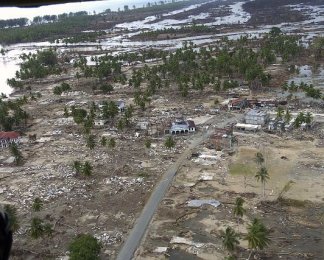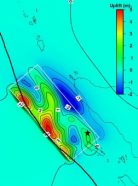Digging into a tsunami disaster
A powerful earthquake under the Indian Ocean changed Earth's surface and spin
By Emily Sohn
The date Dec. 26, 2004, will be long remembered by many people. First, there was a powerful earthquake at the bottom of the Indian Ocean. Then, a massive wave called a tsunami spread out in all directions. When the wave hit the shores of nations surrounding the ocean, more than 145,000 people died.
Now, scientists are using computers and other tools to study how this catastrophic event changed Earth.
 |
|
This aerial view of the village of BanTuan, south of Banda Aceh in Sumatra, Indonesia, shows the damage caused by the recent Indian Ocean tsunami. The huge waves deposited beach sand and soil, stripped away vegetation, and destroyed structures as far inla
|
| U.S. Navy photo by Photographer’s Mate 2nd Class Philip A. McDaniel |
The Indian Ocean earthquake was the largest one in 40 years. On the Richter scale, which rates the strength of earthquakes, the event scored 9.0. That’s about as strong as earthquakes get.
The quake occurred just north of an island in Indonesia called Simeulue. This spot is located in a zone where two immense sections of Earth’s surface—called plates—meet. One section, called the India plate, is slowly sliding under the other section, called the Burma plate, at a rate of about 6 centimeters per year.
In the recent quake, the sudden slippage was much larger. In some places, the plates may have been shoved as much as 20 meters (66 feet) past each other. And some slippage occurred all along 1,200 kilometers of the boundary between the plates. That’s longer than the state of California!
 |
|
This map shows how much the seafloor rose in different places near the earthquake’s center (marked by a star). Red represents the greatest uplift. This sudden rise caused tsunamis that scoured coasts around the Indian Ocean.
|
| Chen Ji, Caltech |
Where the shifting was most extreme, parts of the seafloor suddenly jerked up as much as 5 meters (16 feet). All of the water above the uplifted ground had to move as a result. That’s what caused the tsunami.
Computer studies by Chen Ji, a seismologist at the California Institute of Technology in Pasadena, show that waves raced away from the quake site as fast as a jetliner. The first crash of water hit Sumatra 15 minutes after the quake, with waves as high as 15 meters (49 feet).
Tsunamis hit Thailand 75 minutes after the earthquake. They hit Sri Lanka and India 4 hours after it happened. Disaster even reached as far as Africa. People died in Somalia and Kenya, some 5,000 kilometers (3,100 miles) away from the quake’s center.
Earth is different now. Besides all the wreckage that needs to be cleaned up and the sadness that must be dealt with, some parts of the ocean floor are higher than they were. Some areas are lower.
There have also been changes in Earth’s spin. When the India plate moved closer toward Earth’s center, the planet became like a spinning figure skater who pulls her arms closer to her body. Earth started spinning more quickly. Its daily rotation is now about 2.67 milliseconds faster than it was before.
Earth can feel so solid when you’re standing on it. It’s amazing how quickly everything can get shaken up.







